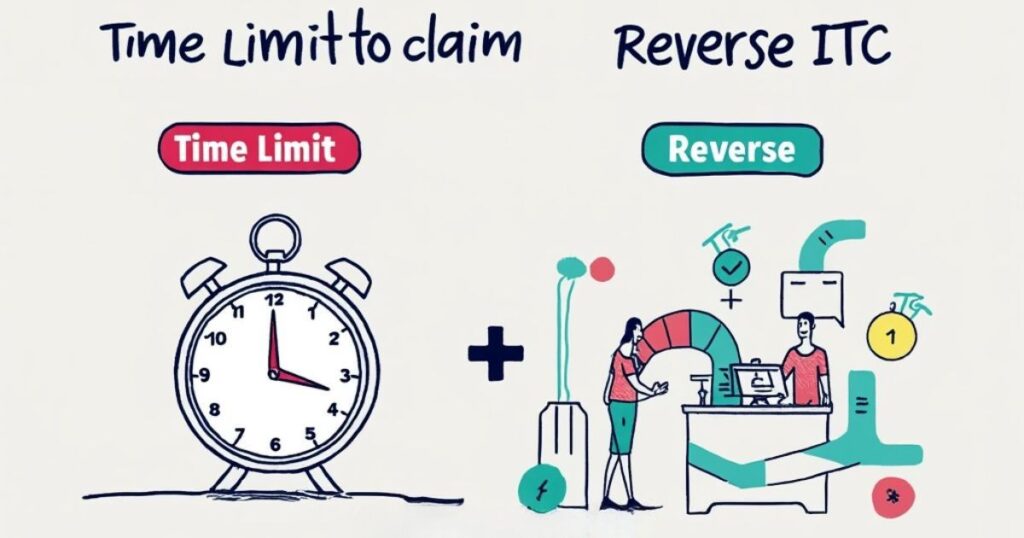Time Limits for Availing ITC: Implications of Section 16(4)
Input Tax Credit (ITC) is a cornerstone of the Goods and Services Tax (GST) system in India, significantly reducing the tax burden for businesses by allowing them to claim credit for GST already paid on their purchases. However, claiming this valuable credit isn’t an indefinite right. The government has set strict deadlines, and failing to meet them can have serious financial consequences. The core provision governing these deadlines is Section 16(4) of the Central Goods and Services Tax (CGST) Act, 2017. Understanding these time limits for availing ITC is absolutely crucial for maintaining your business’s financial health and ensuring you remain compliant with GST regulations. The time limits for availing ITC in India are non-negotiable, making awareness and proactive management essential. This post will break down the specifics of Section 16(4), clearly explain the deadlines for claiming ITC, discuss the significant consequences of missing these cut-off dates, and provide practical best practices to ensure your business stays on track.
What is Input Tax Credit (ITC) under GST?
Defining ITC
Input Tax Credit, or ITC, is essentially the tax that a business pays on its purchases (like raw materials, capital goods, or services used for business operations) which it can then use to reduce its tax liability on sales (output tax). Think of it as getting credit for the GST you’ve already paid within the supply chain. When you make a sale, you collect GST from your customers (output tax). Instead of paying the entire collected amount to the government, you can deduct the GST you paid on your business-related purchases (input tax). This mechanism prevents the cascading effect of taxes (tax on tax) and ensures tax is levied only on the value added at each stage. The GST framework includes Central GST (CGST), State GST (SGST), and Integrated GST (IGST). Generally, CGST credit can be used against CGST liability, SGST credit against SGST liability, and IGST credit against IGST, CGST, and SGST liabilities in a specific order, streamlining the tax settlement process.
Why Timely ITC Claims are Vital for Businesses
Claiming your eligible ITC promptly is not just about following rules; it directly impacts your bottom line and operational efficiency. Firstly, timely ITC claims significantly improve your cash flow. By offsetting your output tax liability with the credit you’re entitled to, you reduce the actual amount of cash you need to pay to the government each tax period. This frees up working capital that can be used for other critical business needs like expansion, inventory, or operational expenses. Secondly, failing to claim ITC within the stipulated deadline represents a direct financial loss. Any ITC that is not claimed by the due date prescribed under Section 16(4) is forfeited permanently – you cannot claim it later. This directly increases your tax outgo and reduces your profitability. Adhering to the ITC claims time limit for businesses India is therefore critical. Lastly, meeting these deadlines is a fundamental aspect of GST compliance. Non-compliance can lead to scrutiny from tax authorities, potential interest, and penalties, disrupting business operations and damaging your compliance record.
If you’re a new business looking to handle GST effectively, consider reading Launching Your Startup Right – Mastering GST Registration in India for crucial insights.
Decoding Section 16(4): The Time Limits for Availing ITC Deadline Rule
Understanding Section 16(4) of the CGST Act
Section 16(4) of the CGST Act, 2017 lays down a crucial condition regarding the time frame within which a registered person must claim ITC. It explicitly states that a taxpayer shall not be entitled to take input tax credit in respect of any invoice or debit note for the supply of goods or services or both after a specific deadline has passed. This provision acts as a hard stop for claiming credits.
The current deadline, as amended by the Finance Act 2022 (effective from October 1, 2022), for claiming ITC related to an invoice or debit note is the earlier of the following two dates:
- 30th day of November following the end of the financial year to which such invoice or debit note pertains.
- The actual date of furnishing the relevant Annual Return (GSTR-9) for that financial year.
Let’s illustrate with an example: Suppose your business received an invoice dated July 15, 2023. This invoice pertains to the Financial Year (FY) 2023-24 (April 1, 2023, to March 31, 2024). According to Section 16(4), the last date to claim the ITC for this specific invoice would be November 30, 2024, unless you file your Annual Return (GSTR-9) for FY 2023-24 before November 30, 2024. If you file your GSTR-9 on, say, October 25, 2024, then October 25, 2024, becomes the effective last date for claiming ITC for any invoices or debit notes pertaining to FY 2023-24. Ensuring section 16(4) compliance for Indian entities requires meticulous tracking of these dates. Proper understanding ITC time limits in India is non-negotiable for businesses seeking to maximize their eligible credits. You can refer to the official legislation on the CBIC website for detailed provisions.
Moreover, businesses must be aware of taxation services in India to better understand their obligations and benefits under various tax laws.
Scope of Section 16(4)
It’s important to understand what falls under the ambit of this time restriction. The deadline imposed by Section 16(4) primarily applies to the Input Tax Credit that businesses claim through their GSTR-3B return. This return is a summary return filed monthly (or quarterly, for QRMP scheme taxpayers) where the net tax liability is calculated and paid, including the declaration of eligible ITC. The time limit applies specifically to ITC availed based on invoices and debit notes received from suppliers for inward supplies.
This restriction covers ITC related to all types of inward supplies used for business purposes, including:
- Inputs: Raw materials or goods used in the production process.
- Input Services: Services used for running the business (e.g., professional fees, rent, advertising).
- Capital Goods: Machinery, equipment, and other assets capitalized in the books of accounts.
Therefore, whether you are purchasing raw materials, paying for software services, or buying new machinery for your factory, the ITC related to the GST paid on these transactions must be claimed within the timeframe specified by Section 16(4).
Consequences of Missing the Section 16(4) Deadline
Financial Impact on Taxpayers
Overlooking the deadline set by Section 16(4) is not a minor administrative lapse; it carries significant and irreversible financial consequences. The most direct impact is the permanent loss of ITC. If you fail to claim the credit for an invoice or debit note by the 30th of November following the end of the financial year or the date of filing the annual return (whichever is earlier), that credit is gone forever. It cannot be claimed in any subsequent tax period, nor can it be claimed through any rectification process after the deadline.
This lost ITC directly leads to an increased tax liability. Since you cannot offset your output GST with the forfeited input tax, you will have to pay a higher amount of GST out of your business’s own funds. This outflow directly affects your working capital and cash reserves. Consequently, the inability to claim entitled credits results in reduced profitability. Every rupee of ITC lost is a rupee added to your costs, thereby eating into your profit margins. These implications of section 16(4) for Indian taxpayers underscore the critical need for timely action and robust internal controls surrounding ITC claims.
Identifying the right system to manage and track financial transactions can be beneficial, as highlighted in our article on how to set up an accounting system for my small business.
Common Pitfalls Leading to Missed Deadlines
Several operational and procedural issues can lead businesses to inadvertently miss the crucial Section 16(4) deadline. Awareness of these common pitfalls is the first step towards prevention:
- Delayed Receipt or Accounting: Sometimes, purchase invoices are physically received late, or there are delays in entering them into the accounting system. If invoices pertaining to a financial year are accounted for after the deadline has passed, the ITC is lost.
- Failure in Reconciliation: Not performing regular (preferably monthly) reconciliation between your purchase records and the auto-populated GSTR-2B statement is a major risk. Without reconciliation, you might miss eligible credits reflected in GSTR-2B or fail to identify discrepancies that need supplier follow-up.
- Supplier Non-Compliance: Your ability to claim ITC often depends on your supplier correctly uploading invoice details in their GSTR-1 return on time. If suppliers delay filing or make errors, the credit might not appear in your GSTR-2B within the claim period, even if you possess the invoice.
- Lack of Awareness: Some businesses, especially smaller ones, might simply be unaware of the specific deadline under Section 16(4) or misunderstand its calculation (e.g., confusing it with the time limit for issuing invoices).
- Poor Internal Processes: Inadequate internal controls for tracking invoices, verifying ITC eligibility, monitoring the GSTR-2B, and ensuring timely filing of GSTR-3B can easily lead to missed deadlines. This includes lack of designated responsibility or reliance on manual, error-prone systems.
Best Practices: Ensuring Timely ITC Claims
Proactive Steps for Compliance
To effectively navigate the time limits for availing ITC and avoid the pitfalls of Section 16(4), businesses must adopt proactive and systematic approaches. Implementing robust internal processes is key to ensuring compliance and maximizing eligible credit. Here are some essential best practices:
- Regular Reconciliation: Make it a non-negotiable monthly task to reconcile your purchase register (books of accounts) with the GSTR-2B statement available on the GST Portal. GSTR-2B provides a static view of the ITC available to you for a particular month based on your suppliers’ filings. This reconciliation helps identify discrepancies early, such as missing invoices or mismatched amounts, allowing you time to follow up before the deadline.
- Systematic Record Keeping: Maintain meticulous and organized records of all purchase invoices and debit notes. Whether digital or physical, ensure records are easily accessible and clearly marked with the relevant financial year. This aids quick verification and retrieval during reconciliation and return filing. Implementing a system where invoices are entered promptly upon receipt is crucial.
- Proactive Supplier Management: Don’t wait until the last minute. Regularly communicate with your suppliers, especially those whose invoices are not reflecting in your GSTR-2B. Encourage them to file their GSTR-1 returns accurately and on time. Establish clear payment terms linked to GST compliance to incentivize timely action from suppliers.
- Utilize Technology: Leverage accounting software or specialized GST compliance tools. Many software solutions offer features for automated GSTR-2B reconciliation, tracking ITC eligibility based on Section 16 conditions, sending reminders for filing deadlines, and maintaining digital records efficiently. This reduces manual errors and improves overall efficiency. Following these guidelines for availing ITC under section 16(4) can save businesses significant amounts in potential lost credits.
How TaxRobo Can Help (Subtle Call-to-Action)
Navigating the complexities of GST compliance, including the strict time limits for availing ITC, can be challenging for busy entrepreneurs and businesses. Ensuring every eligible credit is claimed accurately and on time requires diligence and expertise. TaxRobo offers comprehensive solutions designed to ease this burden. Our Expert GST Return Filing services (TaxRobo GST Service) ensure your GSTR-3B and other returns are filed accurately and punctually, maximizing your ITC claims within the legal framework.
Furthermore, our Accounting & Bookkeeping services (TaxRobo Accounts Service) help maintain the organized and systematic records crucial for tracking purchases and facilitating timely reconciliation. We assist businesses in implementing robust Compliance Management strategies, keeping them updated on evolving GST laws and ensuring adherence to critical deadlines like the one stipulated under Section 16(4). Partnering with TaxRobo allows you to focus on your core business activities, confident that your GST compliance, including the management of time limits for availing ITC, is in expert hands.
Conclusion
Adhering to the time limits for availing ITC as mandated by Section 16(4) of the CGST Act is not just a procedural requirement; it’s a critical financial discipline for every GST-registered business in India. Input Tax Credit is a valuable benefit designed to reduce the tax burden, but this benefit is conditional upon timely action.
The key takeaway is clear: the deadline for claiming ITC on invoices or debit notes pertaining to a financial year is the 30th of November of the subsequent financial year, or the date of filing the Annual Return (GSTR-9) for that year, whichever comes earlier. Missing this deadline results in the permanent forfeiture of the ITC, leading to increased tax payments and reduced profitability.
Therefore, businesses must implement robust processes for diligent record-keeping, regular reconciliation of purchases with GSTR-2B, proactive supplier communication, and timely filing of GST returns. Don’t let procedural delays cost you valuable input tax credits. If managing GST compliance and ITC claims seems overwhelming, don’t hesitate to seek professional help. Contact TaxRobo today for expert assistance (TaxRobo Online CA Consultation Service) and ensure you never miss these crucial deadlines, safeguarding your business’s financial health.
Frequently Asked Questions (FAQs)
Q1: What is the specific deadline under Section 16(4) to claim ITC for invoices pertaining to FY 2023-24?
A: The last date to claim Input Tax Credit (ITC) for any invoice or debit note that pertains to the Financial Year 2023-24 (i.e., dated between April 1, 2023, and March 31, 2024) is November 30, 2024, OR the date on which you furnish your Annual Return (GSTR-9) for FY 2023-24, whichever date is earlier.
Q2: Does Section 16(4) apply to ITC on Reverse Charge Mechanism (RCM) liabilities?
A: Yes, the time limit specified under Section 16(4) generally applies to claiming ITC on tax paid under the Reverse Charge Mechanism (RCM) as well. The time limit is linked to the debit note or invoice pertaining to the supply. For RCM liabilities where you issue a self-invoice, the date of such document becomes relevant for determining the financial year and the corresponding deadline under Section 16(4). You must pay the RCM liability first and can then claim ITC subject to this time limit and other conditions.
Q3: If I missed the deadline mentioned in Section 16(4), can I request an extension or claim the ITC later?
A: No, the restriction imposed by Section 16(4) is mandatory and legally binding. Once the deadline (30th November of the next FY or annual return filing date, whichever is earlier) has passed for a particular invoice or debit note, the related ITC is permanently lost. There is generally no provision within the GST law to grant an extension for this deadline or allow taxpayers to claim such lapsed ITC in subsequent tax periods. It’s crucial to respect the time limits for availing ITC.
Q4: My supplier filed their GSTR-1 late, after the Section 16(4) deadline passed for me. Can I still claim ITC?
A: No. Your eligibility to claim ITC is governed by the deadline specified in Section 16(4) applicable to you, the recipient. This deadline is independent of when your supplier uploads the invoice details in their GSTR-1. Even if the supplier uploads the invoice after your Section 16(4) deadline for that financial year has passed, and it subsequently appears in your GSTR-2B, you are no longer legally entitled to claim that ITC. This highlights the importance of proactive follow-up with suppliers well before your deadline approaches.
Q5: How does GSTR-2B help in managing the time limits for availing ITC?
A: GSTR-2B is an auto-drafted, static Input Tax Credit statement generated for every registered person based on the GSTR-1 filed by their suppliers. It provides a clear view of the ITC available for a specific month, including details from invoices and debit notes uploaded by suppliers. Regularly (ideally monthly) reconciling your purchase records with your GSTR-2B helps you:
- Identify eligible ITC promptly as it becomes available.
- Spot missing credits (invoices you have but aren’t reflected) allowing timely follow-up with suppliers.
- Ensure you claim the available credits in your GSTR-3B well before the overarching Section 16(4) time limits for availing ITC approach for the relevant financial year.



